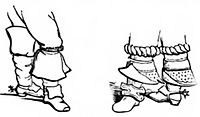coloured satins, of the most gorgeous hues, abounded. The cushions of couches and chairs were equally costly, and instead of the ancient tapestry, paper and leather hangings, richly stamped and gilt, covered the walls. The Flemish artists had been called in to paint the ceilings with historic

An Exquisite of the time of Charles I. Copied from a Broadside, Date 1646.
or mythologic scenes, and on the walls hung the masterpieces of Flemish and Italian art. Carpets were beginning to supersede rushes on the floors, but were more commonly used as coverings for tables.

Puritans. From Engravings published in 1646 and 1649.
In addition to the carved cabinets of oak, ebony, and ivory, and the richly covered cushioned and high backed chairs of the Tudor dynasty, Flemish and Dutch furniture of somewhat formal but still elegant design abounded. Superb ornaments of ivory and china had found their way from the East, and became heir-looms in great mansions. Altogether, the houses of the wealthy of these times presented a scene of stately elegance and luxury that has not since been surpassed.
COSTUME.
The costume of the reign of James was but a continuation of that of Elizabeth. The men still wore the stiff plaited ruff, occasionally varied by a plain horizontal one with lace on its hedges.

Dresses of the Protectorate.Copied from the tomb of Hyacinth and Elizabeth Sacheverel, date 1657.
The long peasecod-bellied doublet continued, and the large stuffed Gallic or Venetian hose, slashed and quilted, had assumed more preposterous dimensions from James's timidity; he having both these and the doublets quilted to resist the stabs of the stiletto. In such a suit we have James painted repeatedly. Towards the end of his reign a change was noticeable. Instead of the long-waisted doublet there were short jackets, with false hanging sleeves behind; the trunk hose were covered with embroidered straps, tucked short at the thigh, and the hose gartered below the knee, as we see in the figure of prince Henry at his martial exercises.

Boots of the Reign of Charles I.
We have noticed how they covered their cloaks and dresses with jewels on state occasions. They wore feathers at such times in their hats. Taylor, the water poet, says the gallants of his time,—
Wore a farm in shoestrings edged with gold.
And spangled garters worth a copyhold;
